Hints and Teasers
Helpful Hints 5
by Lew Buller
Bonsai Myths, Approach Grafting, Five-gallon buckets, Tool box, Computer calendar
“Copper hardens due to sun and weather as it ages on the tree.” Not true. Copper hardens when it flexes; the grains in the copper become larger when it is flexed and therefore stiffer.
“Water drops on plants act like magnifying glasses and burn the foliage.” This myth was laid to rest by Professor Amy Liang who measured the amount of solar energy coming through a drop of water. As she reported in her book The Living Art of Bonsai, Sterling Publishing Company, New York, 1992, p. 182. “...its energy is only 0.2 calorie per minute. It is, therefore, incapable of burning leaves.” Her book is excellent, full of color photographs, color drawings, and black-and-white drawings for a total of 288 pages.
Approach Grafting
To make sure I am not repeating something that has already been done, I check the Internet. Some well-written articles on approach grafting are available there. While approach grafting is used interchangeably with inarch grafting, technically inarch grafting is used to replace the root system on a tree. Splice grafting is a variation on approach grafting in which the two trees are parallel rather than having one cross over the other.
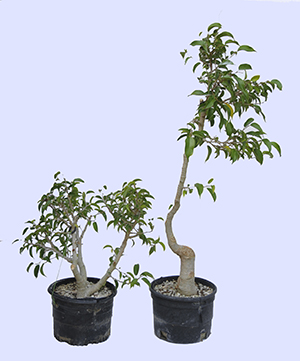
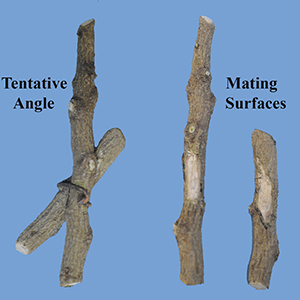
The trees I am using are Ficus Benjamina “Little Lucy.” I don’t want a new branch emerging from the outside of the curve on the taller tree. If I did, a splice graft would work. I want a branch to emerge from the inside of the curve so that after the graft takes, I can cut the long thin top off. That’s why my test shows the scion crossing at an angle. I fitted the two test pieces together at the planned angle, and drew lines I could follow to create the cuts. I use the sharpest tools I have because clean cuts heal faster.
One cut is deeper than the other. Because the small tree (the scion) has more foliage to save and needs a greater source of water and nutrients, the deeper cut is in the host. The cut in the scion is not so deep, saving as much of its life line as possible,. I left little extra space because I want the cambiums to grow together as quickly as possible.
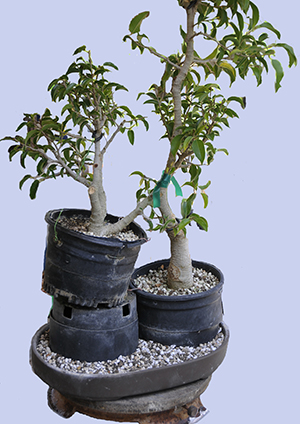
Getting the scion where I want it will create an awkward position. Approach grafting requires stability for both pots as movement by either will break the graft free. The result is this Rube Goldberg setup.
The soil in the bonsai pot serves two purposes. It holds the two growing pots in place and I expect the roots of the host tree to escape their pot and work their way out into the surrounding soil. The two trees were tied together with green garden tape to test stability.
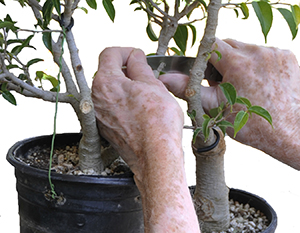
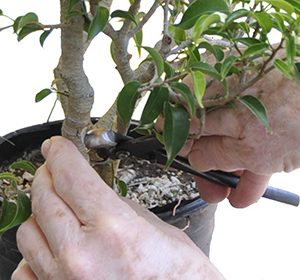
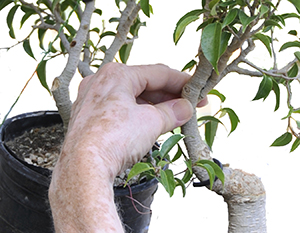
Removing the tape gave space to begin the cuts. The first cut was made on the scion with a knife, starting with a small cut and gradually working out to the lines drawn to mark the size of the cut.
The cut on the host was made with a small knob cutter whose bite was exactly the width of the scion’s trunk. The host cut was both wider and deeper. A quick check showed the two cuts fit together well.
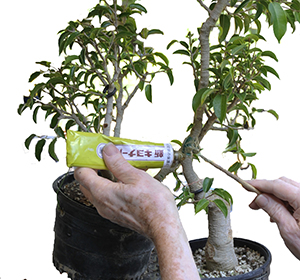
To complete the graft, the two trees were tied together tightly and the tape and a little bit of the surrounding cambium were covered with wound seal. It will be at least six months, perhaps a year, before I remove the tape and check the graft. In the meantime, I will watch the leaves. If a few turn yellow and fall off, that’s natural. Ficus often drop leaves when they are moved from one location to another. If a lot of leaves fall from either tree, I may have to separate them and save the stronger tree.
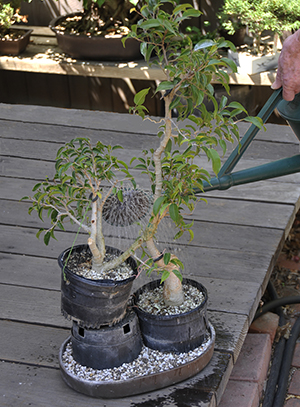
The final step was to water the plants. The left pot is on a slant, so I will add some soil to the right side of that pot and see that it doesn’t wash away. They will be watered and fertilized on the same schedules as my other bonsai.
If you decide to try either approach grafting or splice grafting, practice first on some scrap material, especially if you have never tried fastening two round objects together. Before you try the real thing, take some scrap branches of about the same diameter as the ones you plan to graft and see how deep to cut, what shape to cut, and how to match the cambiums on both pieces.
Five-gallon buckets
I use these to mix soil, (I mix soil during winter down time), collect pumice from the wholesale soil company, carry supplies, store cottonseed meal and alfalfa pellets–the list could go on and on. I got my buckets at a donut store that sells filled donuts and donuts with fancy toppings. The fillings and toppings are not made on site, but rather bought in 5-gallon buckets. The last time I picked up some buckets, I paid 50 cents a piece for them, substantially less that the cost at local building supply stores. All I had to do was wash them. Get buckets with handles if you can.
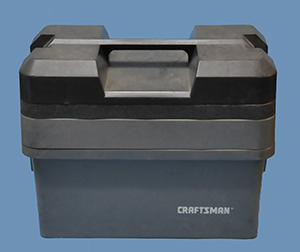
Tool box
If you are serious about bonsai, you are going to acquire a lot of tools over time. Plan for it and get a compartmentalized tool box that holds a lot but that can still be carried without causing a hernia. Here’s what I have been using for the past 18 years:
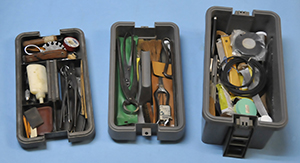
The top tray has the tools I use most, the middle tray has the big tools, and the bottom holds everything else.
Computer calendar
Use it to keep track of activities involving your entire collection. List days for fertilizing, for foliar spraying, for transplanting and watering as watering needs change during the year. If you have a large collection, you may want to make up a standard format for spreadsheets, keeping track of such things as source of plant, price, transplant dates, trimming, wiring, and anything else you do. Make several copies, put them in a 3-ring binder, and fill them in by hand as you work on trees. The small plastic plant stakes don’t hold much information and the ink tends to come off after it has been watered a while.
Cell phones make it very easy to take photos of your bonsai. You will be amazed by how much you can learn by looking at photos of your trees.

